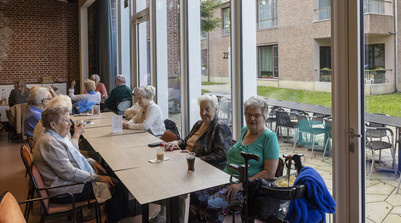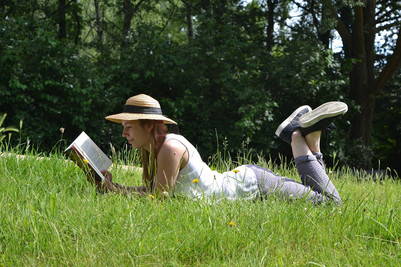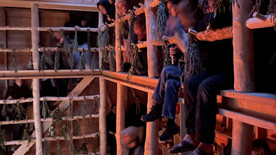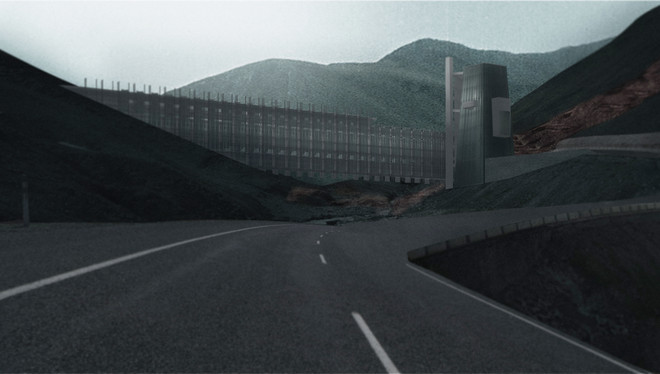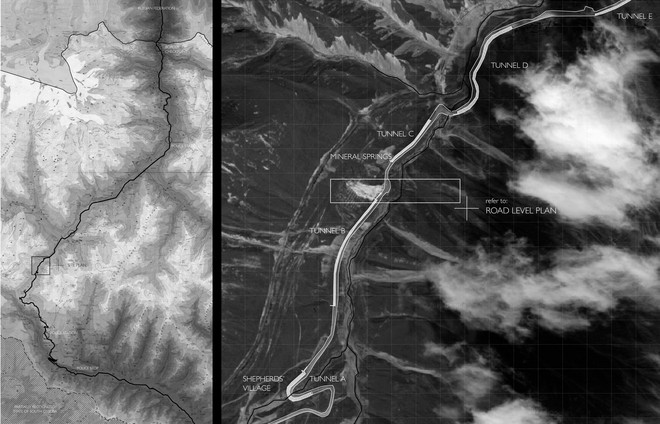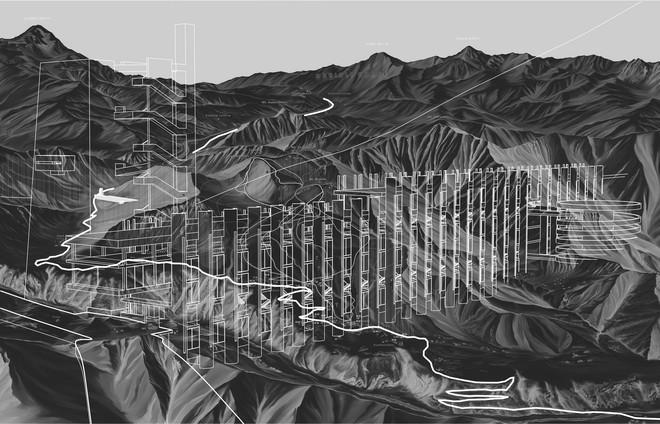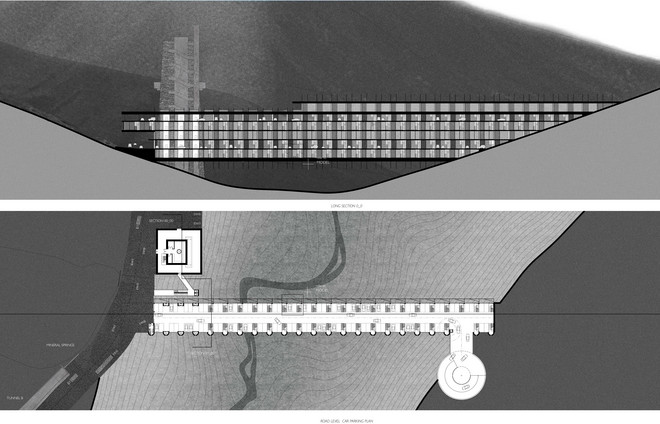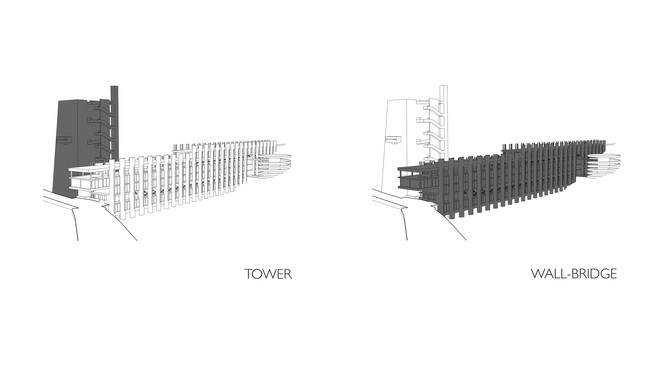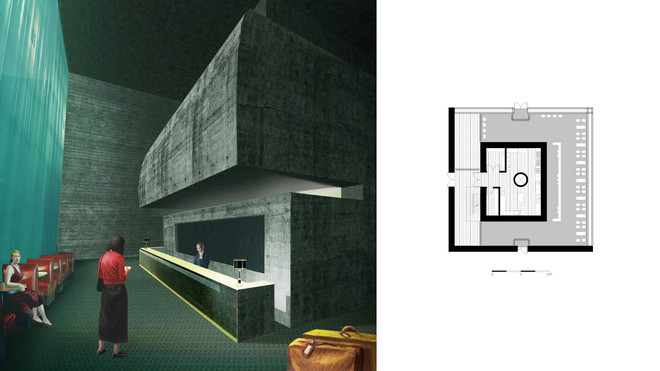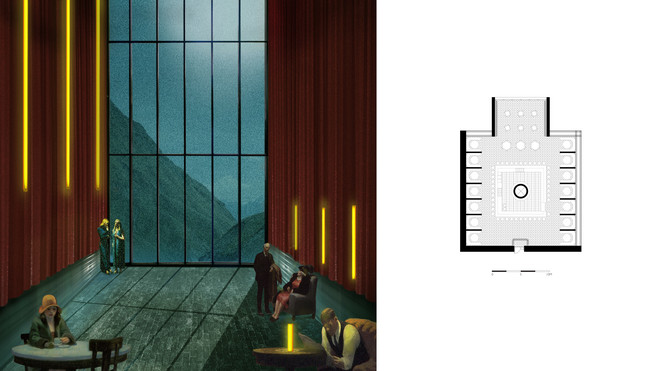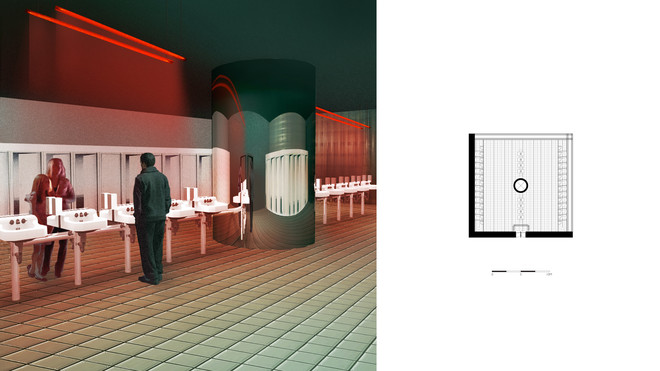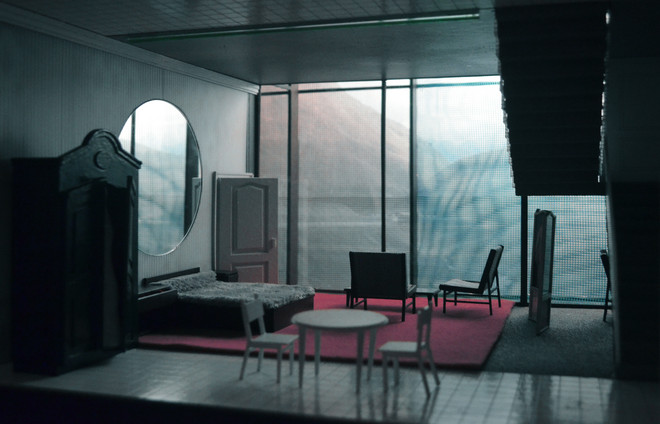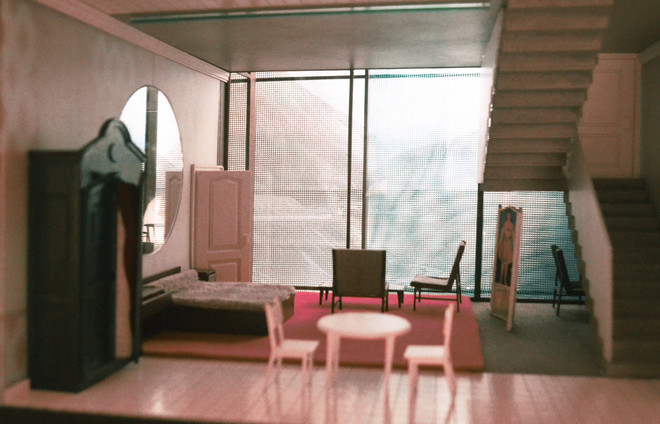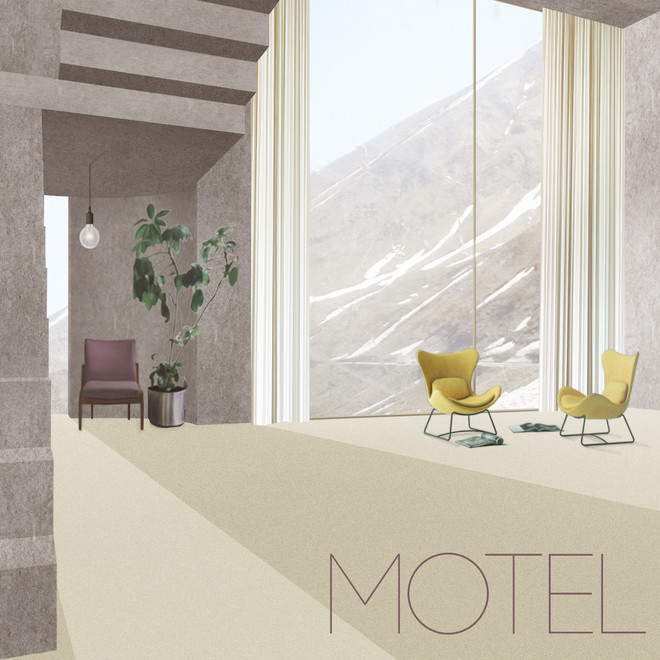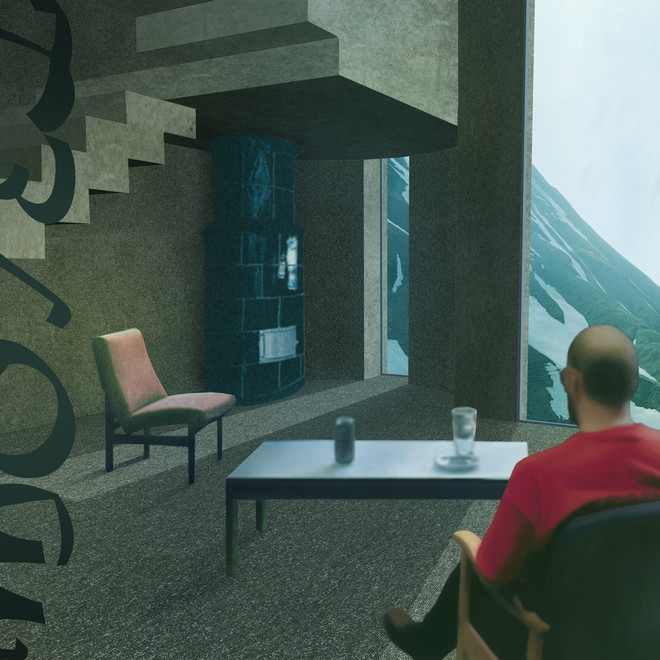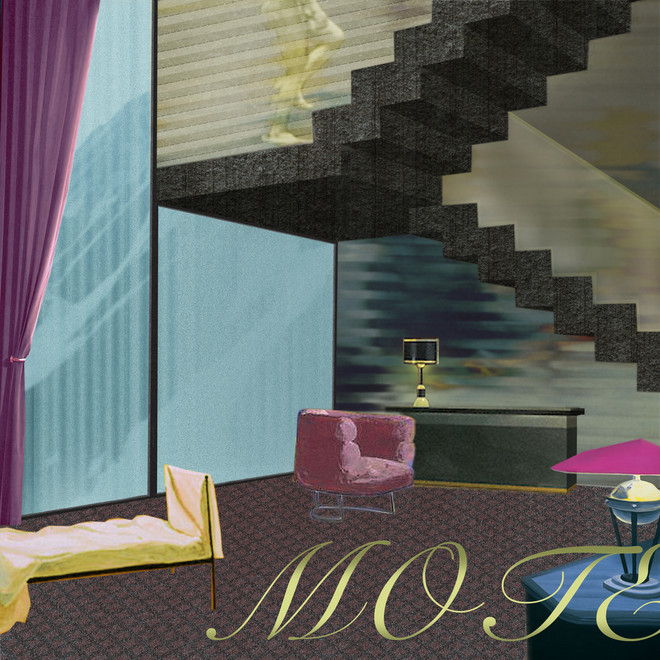
The Georgian Military Road
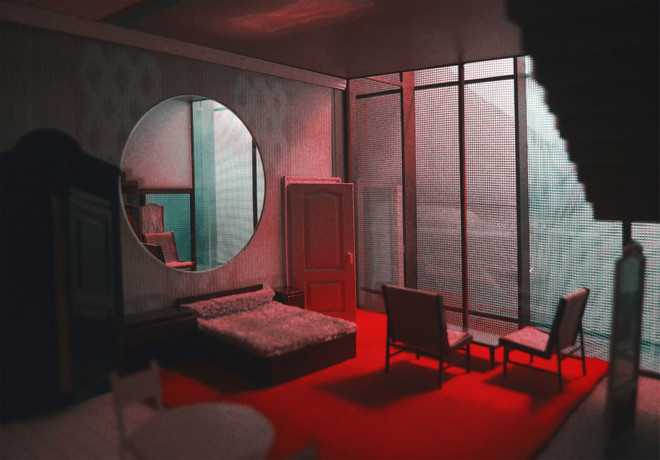
MOTEL FOR MILITARY ESCAPISM
Georgia is often a passive spectator and victim of geopolitical shifts. Religious, ideological, empire boundaries moved back and forth through its present territory. The Caucasus Mountains stood against this movement. To cross the range meant for a political will to overcome a force of nature. The Georgian Military Road, connecting the Georgian capital Tbilisi and the Russian city Vladikavkaz [lit. ruler of the Caucasus], re-enacts and saturates the friction between the two countries as well as geopolitical and natural forces. The proposed motel as a part of the Road’s complex deals with the feeling of personal hopelessness that can ensue. Building on Theodor Fontane’s advocacy for escapism, that ‘we cannot do without auxiliary constructions’, the project uses tourism to propose an intervention that enacts the fear of war, occupation and struggle between the conflicts of geopolitics, nature and the self.
The two-part volumetric composition of a motel alludes to the traditional Caucasus Mountains military tower typology and the long room block to the conflicting programs of a defensive wall and a connecting bridge. The mountainous landscape is a setting for play in scale and size: the tower is three-times the dimensions of a traditional prototype and the room block spans a river valley of around 250 meters. Approaching from the Tbilisi side the motel camouflages itself through the usage of stone and gravel for a rough concrete from a nearby quarry. From the Russian side the disguise is achieved through an ephemeral tarpaulin elevation system, the brought to be ‘local’ material of the kilometers of trucks along the Georgian Military Road waiting to pass the border.
THE TOWER
The motel tower is based on the traditional to Caucasus Mountains defensive tower typology. It plays with the cultural notions of hospitality and hostility.
Reception: Dichotomy between hospitality and hostility expressed through formal bunker appearance and reception function.
Diner: Georgian feast tradition dispersed into dining booths and small tables in a mountainous space.
Bar: Protruding ‘shooting’ alcoves observe the outside while reflective delivery li creates a self surveillance device.
Bathroom: The single space of the bathroom is accessed through two gender prescribed doors. The room is divided by the mirroring of its elements and the ephemeral ‘partition’ of light.
MOTEL ROOMS

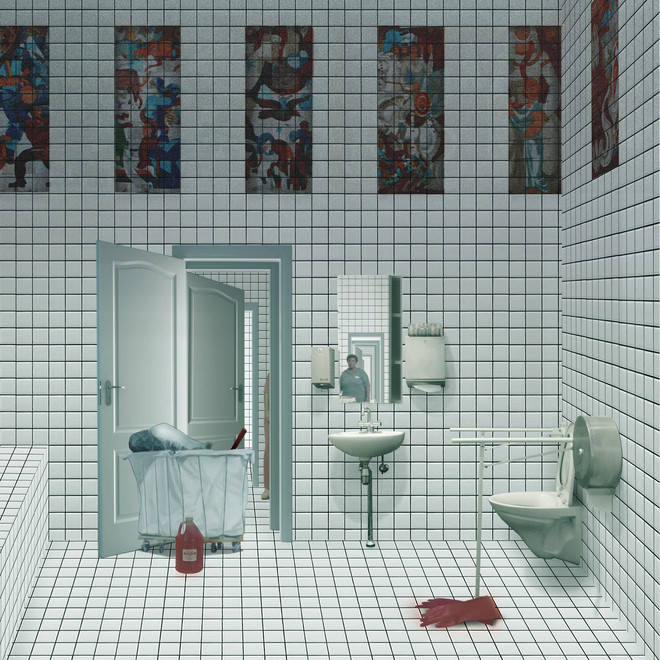
Collages representing the motel rooms form a significant part of the project. They reference various works of art pertaining broadly speaking to the conflicts of the politics and the self. As an example, The Russia – Georgia Friendship Monument that was built at the Georgian Military Road in 1983 to celebrate the bicentenary of the Treaty of Georgievsk is directly referenced in ROOM – 004. The formal appearance of the look-out monument resembles the ruins of a fortress. The mosaic is reminiscent of the Georgian religious fresco tradition. During the enemy invasions many of the frescoes have been vandalized and in some cases entire interior spaces whitewashed. Similarly, at this monument the Soviet interpretation of history and the idea of a bright future is imposed on the wall through the mosaics o en used as a tool of propaganda during Soviet times. Indirectly, the collage refers to the works by a Brazilian artist Adriana Varejao, who explores history through the relation between the rational: the geometry and cool surface of ceramic tiles, a tradition in Brazil and Portugal, and the irrational: the human body and nature expressed through meat. The tiles are drastically cut as a metaphor for ‘the violence and cruelty of colonization’ revealing ‘entrails and viscera, the irrational, emotional, and the painful’.*In this room all surfaces, including the ceiling, are tiled. The mosaic and white tiling is di erent and grout lines at the corners slightly miss each other, signifying work done in a hurry to hide something behind the surface.
*Rosa, Federico. 2017. “Adriana Varejão: A History Of Flesh”. Culture Trip. https:// theculturetrip.com/south-america/brazil/articles/adriana-varej-o-a-history-of-flesh-/.
MOTEL ROOM BOOK
DIORAMA
One of the rooms is displayed as a diorama to place the viewer of the project in the role of a motel visitor. It draws from the ideas present in the worlds made by Charles Matton, as described by Jean Baudrillard ,’when they are condensed in a marvelously small space, one rediscovers their quintessence. Recreating a space and a scene on a smaller scale convinces us to enter it more intimately.’ The diorama was also used to investigate the light conditions: outside light filtered through double tarpaulin mesh facade system and light in an adjacent room through a translucent tarpaulin partition.
CONNECTING DOORS
Numerous variations of rooms are connected with each other through three types of doors. Each metaphorically portrays political actions: a_ invasion represented by the door operable from only one of the rooms, b_ diplomacy represented by the double connecting door and c_ entrapment within state borders represented by the ‘door to nowhere’.
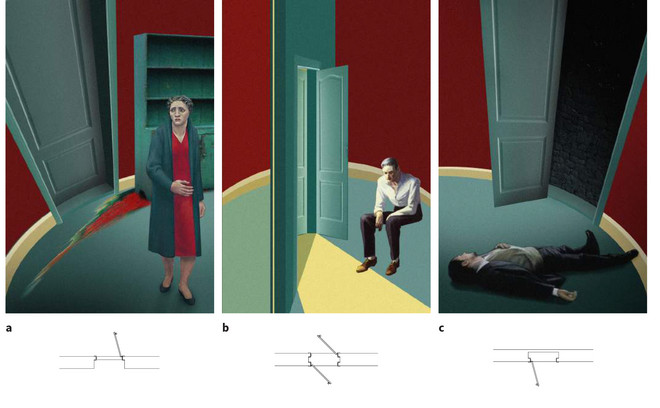
The collage alludes to a ‘Triptych Inspired by the Oresteia of Aeschylus’ (1981) by Francis Bacon which in turn refers to a trilogy of Greek tragedies concerning retaliation and justice. They portray the transition from personal revenge to the social construct of punishment. Contrary, the doors between rooms reverse the transition, enabling the personalisation of normative social constructs through enacting the encountered challenges of the architecture.
MOTEL SHOWROOMS
WHAT IS POSSIBLE FOR THE ARTIST IN ART IS NOT POSSIBLE FOR THE ARCHITECT IN THE WORLD. COMPARED WITH THE RADICALISM OF ART, ARCHITECTURE WILL ALWAYS BE HALF-HEARTED AND IDEOLOGICALLY UNRELIABLE. ARCHITECTURE CAN PERHAPS BE RADICALLLY POSITIVE... BUT OF GREATER RELEVANCE IS THAT A WORK OF ARCHITECTURE IS NEVER MERELY OR FUNDAMENTALLY A 'NO'.*
*Bart Verschaffel, ‘Art in [and of] Architecture: Autonomy and Medium’, in : Greig Chrysler, et al. [eds.], The SAGE Handbook of Architectural Theory [London: Sage Publications Ltd., 2012],173.
One of the collage sets represent so called showrooms. In regard to being ‘radically positive’ the motel satirizes the appeal of style. The space of each room is exactly the same, yet the surface treatment as well as furnishings are used to create a caricatural image of a halcyon motel; pastel colored minimalism for those willing to be European [a], luxurious kitsch for nouveaux riches [b], local and authentic for the well-educated [c] and everything at once for those fashionably cynical [d]. It is hoped that by luring these different groups of people to the motel where each room is a stage and a scenography the people [not the architecture] will be able to say ‘no’ (at least at a personal level of a mundane door opening to the neighboring room) to the fear of war and occupation and face the struggle between the conflicts of geopolitics and the self.




